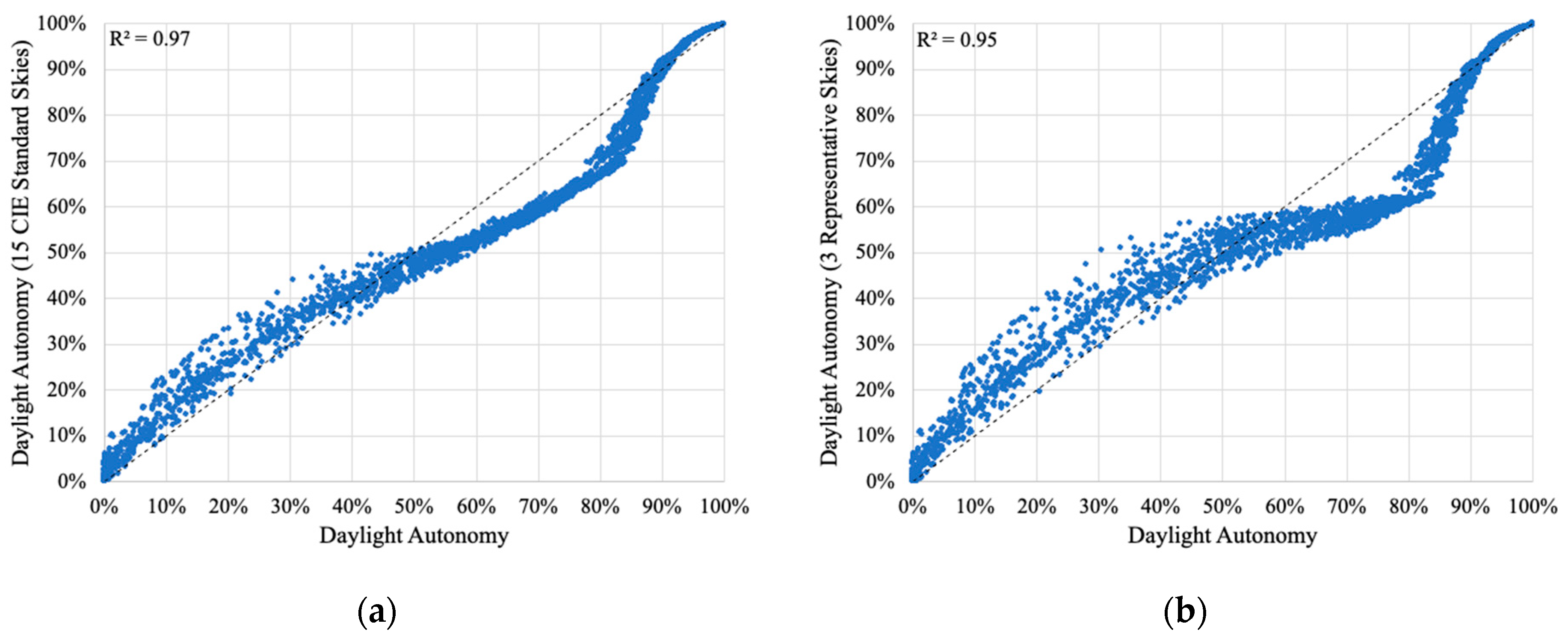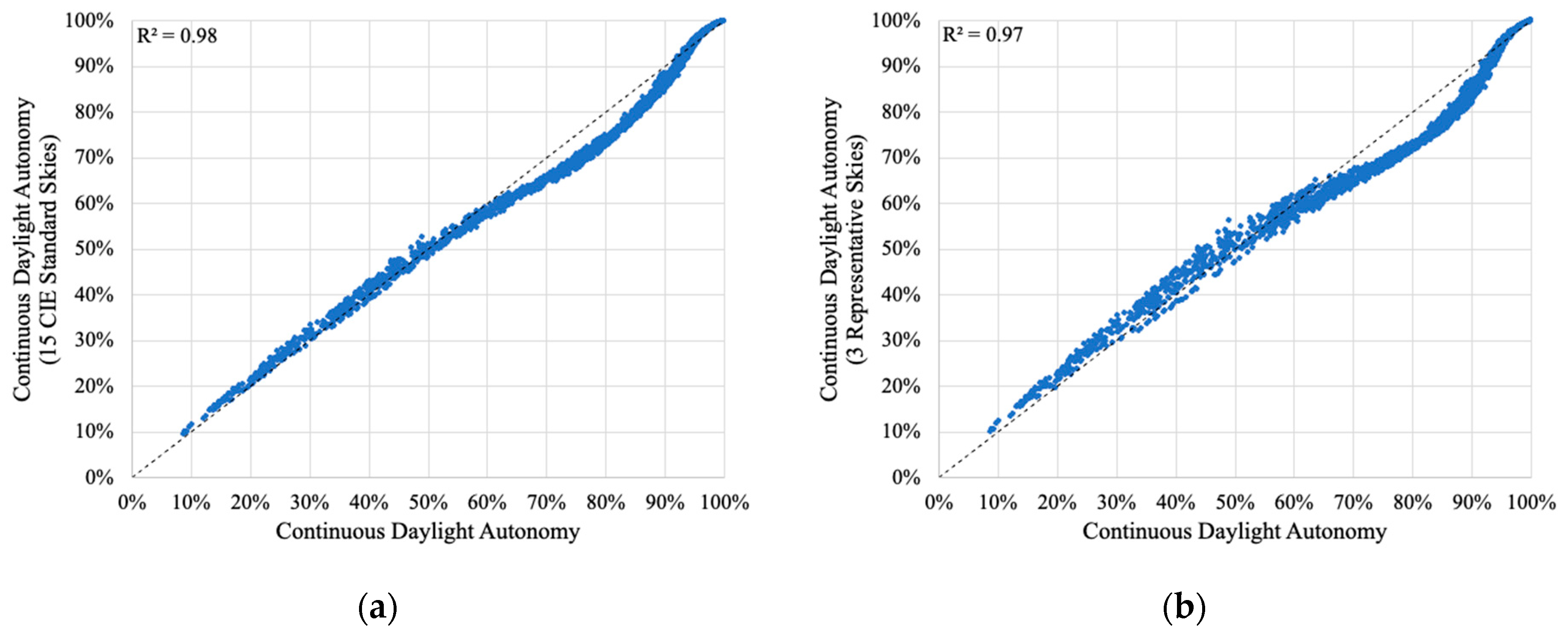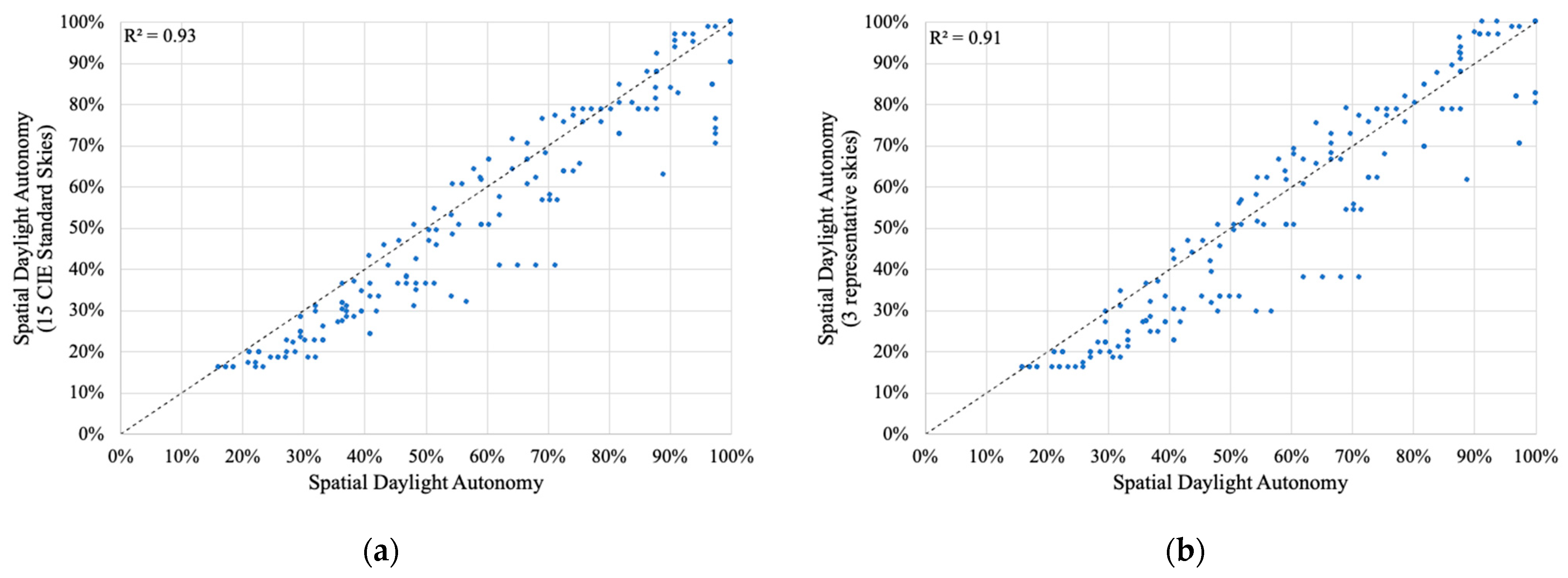Determination of Climate-Based Daylight Metrics under 15 CIE (International Commission on Illumination) Standard Skies and Three Representative Skies
Abstract
:1. Introduction
2. Methodology
- αS is the altitude angle of the sun;
- ε is eccentricity correction factor = 1 + 0.034 × cos (2π (J − 2)/365);
- J is the number of a day within a year;
- m is the relative optical air mass of the atmosphere = 1/(sin αS + 0.50572 × (αS + 6.07995°) −1.6364);
- αV is the extinction coefficient of the ideally clean and dry atmosphere = 1/(9.9 + 0.043 × m);
- TV is turbidity factor in the direction of solar beams;
- and EHD/Evoh is the typical ratio of EHD and Evoh (extraterrestrial flux falling on the horizontal surface) [23].
3. Computer Simulation and Case Study
4. Analysis of Results
5. Conclusions
Author Contributions
Funding
Data Availability Statement
Acknowledgments
Conflicts of Interest
Nomenclature
| αS | Altitude angle of the sun, degree |
| αV | Extinction coefficient of the ideally clean and dry atmosphere |
| ε | Eccentricity correction factor |
| J | The number of a day within a year |
| m | Relative optical air mass of the atmosphere |
| TV | Turbidity factor in the direction of solar beams |
| EHB | Direct sunlight, lux |
| EHD | Diffuse illuminance on the unobstructed horizontal plane, lux |
| Evoh | Extraterrestrial flux falling on the horizontal surface, lux |
| Abbreviations | |
| ADF | Average Daylight Factor |
| CBDM | Climate-Based Daylight Metrics |
| cDA | Continuous Daylight Autonomy |
| CIE | International Commission on Illumination |
| CIESSs | CIE Standard Skies |
| DA | Daylight Autonomy |
| DMFs | Daylight Factor Matrices |
| FOC | Frequency of Occurrence |
| LEED | Leadership in Energy and Environmental Design |
| MBEs | Mean bias error |
| mDA | Maximum Daylight Autonomy |
| Point Daylight Factor | |
| RMSEs | Root Mean Square Error |
| RSs | Representative Skies |
| sDA | Spatial Daylight Autonomy |
| UDI | Useful Daylight Illuminance |
References
- Zarghami, E.; Fatourehchi, D.; Karamloo, M. Impact of Daylighting Design Strategies on Social Sustainability Through the Built Environment. Sustain. Dev. 2017, 25, 504–527. [Google Scholar] [CrossRef]
- Kwong, Q.J. Light level, visual comfort and lighting energy savings potential in a green-certified high-rise building. J. Build. Eng. 2020, 29, 101198. [Google Scholar] [CrossRef]
- Nasrollahzadeh, N. Comprehensive building envelope optimization: Improving energy, daylight, and thermal comfort performance of the dwelling unit. J. Build. Eng. 2021, 44, 103418. [Google Scholar] [CrossRef]
- Gago, E.J.; Muneer, T.; Knez, M.; Köster, H. Natural light controls and guides in buildings. Energy saving for electrical lighting, reduction of cooling load. Renew. Sustain. Energy Rev. 2015, 41, 1–13. [Google Scholar] [CrossRef]
- Asfour, O.S. A comparison between the daylighting and energy performance of courtyard and atrium buildings considering the hot climate of Saudi Arabia. J. Build. Eng. 2020, 30, 101299. [Google Scholar] [CrossRef]
- Acosta, I.; Campano, M.Á.; Molina, J.F. Window design in architecture: Analysis of energy savings for lighting and visual comfort in residential spaces. Appl. Energy 2016, 168, 493–506. [Google Scholar] [CrossRef]
- Munoz, C.M.; Esquivias, P.M.; Moreno, M.; Acosta, A.; Navarro, J. Climate-based daylighting analysis for the effects of location, orientation and obstruction. Light. Res. Technol. 2014, 46, 268–280. [Google Scholar] [CrossRef]
- Ruiz, A.; Campano, M.Á.; Acosta, I.; Luque, Ó. Partial Daylight Autonomy (DAp): A New Lighting Dynamic Metric to Optimize the Design of Windows for Seasonal Use Spaces. Appl. Sci. 2021, 11, 8228. [Google Scholar] [CrossRef]
- Zoure, A.N.; Genovese, P.V. Implementing natural ventilation and daylighting strategies for thermal comfort and energy efficiency in office buildings in Burkina Faso. Energy Rep. 2023, 9, 3319–3342. [Google Scholar] [CrossRef]
- Campano, M.Á.; Acosta, I.; Domínguez, S.; López-Lovillo, R. Dynamic analysis of office lighting smart controls management based on user requirements. Autom. Constr. 2022, 133, 104021. [Google Scholar] [CrossRef]
- Piraei, F.; Matusiak, B.; Lo Verso, V.R.M. Evaluation and Optimization of Daylighting in Heritage Buildings: A Case-Study at High Latitudes. Buildings 2022, 12, 2045. [Google Scholar] [CrossRef]
- Overen, O.K.; Meyer, E.L.; Makaka, G. Daylighting Assessment of a Heritage Place of Instruction and Office Building in Alice, South Africa. Buildings 2023, 13, 1932. [Google Scholar] [CrossRef]
- Tsagrassoulis, A.; Kontadakis, A.; Roetzel, A. Comparing climate based daylight modelling with daylight factor assessment–implications for architects. In Proceedings of the 49th International Conference of the Architectural Science Association, Melbourne, VIC, Australia, 1 January 2015. [Google Scholar]
- Pellegrino, A.; Cammarano, S.; Lo Verso, V.R.M.; Corrado, V. Impact of daylighting on total energy use in offices of varying architectural features in Italy: Results from a parametric study. Build. Environ. 2017, 113, 151–162. [Google Scholar] [CrossRef]
- Gibson, T.; Krarti, M. Analysis of End-Use Impact of Daylighting and Glare Controls for Private Office Spaces. Leukos 2014, 11, 61–87. [Google Scholar] [CrossRef]
- U.S. Green Building Coumcil. LEED v4.1_Building Design and Construction; U.S. Green Building Coumcil: Washington, DC, USA, 2021. [Google Scholar]
- CIE. Spatial Distribution of Daylight-CIE Standard General Sky; CIE General Bureau: Vienna, Austria, 2003. [Google Scholar]
- Tregenza, P.R. Standard skies for maritime climates. Light. Res. Technol. 1999, 31, 92–106. [Google Scholar] [CrossRef]
- Ho, J.C.K.; Ng, E.; Chan, P.W. Predicting the hourly Hong Kong representative sky from typical meteorological year data for dynamic daylighting simulation. Light. Res. Technol. 2015, 47, 730–739. [Google Scholar] [CrossRef]
- Ng, E.; Cheng, V.; Gadi, A.; Mu, J.; Lee, M.; Gadi, A. Defining standard skies for Hong Kong. Build. Environ. 2007, 42, 866–876. [Google Scholar] [CrossRef]
- Kittler, R.; Darula, S. Parametric definition of the daylight climate. Renew. Energy 2002, 26, 177–187. [Google Scholar] [CrossRef]
- Kittler, R.; Darula, S.; Perez, R. A Set of Standard Skies; Ploygrafia: Bratislava, Slovakia, 1998. [Google Scholar]
- CIE. Technical Report CIE Standard General Sky Guide; CIE Central Bureau: Vienna, Austria, 2014. [Google Scholar]
- Ward, G.L.; Shakespeare, R. Rendering with RADIANCE. The Art and Science of Lighting Visualization; Morgan Kaufmann: Los Altos, CA, USA, 1998. [Google Scholar]
- Radiance—Radsite. Lawrence Berkeley National Laboratory (LBNL) Building Technologies Department. Available online: https://www.radiance-online.org/ (accessed on 1 April 2023).
- Sorooshnia, E.; Rahnamayiezekavat, P.; Rashidi, M.; Sadeghi, M.; Samali, B. Passive Intelligent Kinetic External Dynamic Shade Design for Improving Indoor Comfort and Minimizing Energy Consumption. Buildings 2023, 13, 1090. [Google Scholar] [CrossRef]
- Xie, F.; Song, H.; Zhang, H. Research on Light Comfort of Waiting Hall of High-Speed Railway Station in Cold Region Based on Interpretable Machine Learning. Buildings 2023, 13, 1105. [Google Scholar] [CrossRef]
- He, Y.; Arens, E.; Li, N.; Wang, Z.; Zhang, H.; Yongga, A.; Yuan, C. Modeling solar radiation on a human body indoors by a novel mathematical model. Build. Environ. 2021, 187, 107421. [Google Scholar] [CrossRef]
- Tian, Z.; Lei, Y.; Jonsson, J.C. Daylight luminous environment with prismatic film glazing in deep depth manufacture buildings. Build. Simul. 2018, 12, 129–140. [Google Scholar] [CrossRef]
- Welle, B.; Haymaker, J.; Rogers, Z. ThermalOpt: A methodology for automated BIM-based multidisciplinary thermal simulation for use in optimization environments. Build. Simul. 2011, 4, 293–313. [Google Scholar] [CrossRef]
- Kim, C.-S.; Seo, K.-W. Integrated daylighting simulation into the architectural design process for museums. Build. Simul. 2012, 5, 325–336. [Google Scholar] [CrossRef]
- Li, D.H.W.; Tang, H.L. Standard skies classification in Hong Kong. J. Atmos. Sol. Terr. Phys. 2008, 70, 1222–1230. [Google Scholar] [CrossRef]
- IES. Approved Method: Spatial Daylight Autonomy and Annual Sunlight Exposure; IES: New York, NY, USA, 2012. [Google Scholar]
- Li, D.H.W.; Tang, H.L.; Lee, E.W.M.; Muneer, T. Classification of CIE standard skies using probabilistic neural networks. Int. J. Climatol. 2009, 30, 305–315. [Google Scholar] [CrossRef]
- Li, D.H.W.; Chau, T.C.; Wan, K.K.W. A review of the CIE general sky classification approaches. Renew. Sustain. Energy Rev. 2014, 31, 563–574. [Google Scholar] [CrossRef]
- Wittkopf, S.K.; Soon, L.K. Analysing sky luminance scans and predicting frequent sky patterns in Singapore. Light. Res. Technol. 2007, 39, 31–51. [Google Scholar] [CrossRef]
- Luo, T.; Yan, D.; Lin, R.; Zhao, J. Sky-luminance distribution in Beijing. Light. Res. Technol. 2014, 47, 349–359. [Google Scholar] [CrossRef]
- Lou, S.; Li, D.H.W.; Lam, J.C. CIE Standard Sky classification by accessible climatic indices. Renew. Energy 2017, 113, 347–356. [Google Scholar] [CrossRef]
- Wang, J.; Wei, M.; Ruan, X. Characterization of the acceptable daylight quality in typical residential buildings in Hong Kong. Build. Environ. 2020, 182, 107094. [Google Scholar] [CrossRef]
- Gibson, T.; Krarti, M. Comparative Analysis of Prediction Accuracy from Daylighting Simulation Tools. Leukos 2014, 11, 49–60. [Google Scholar] [CrossRef]
- Li, S.; Li, D.H.W.; Chen, W.; Lou, S.; Tsang, E.K.W. Simple mathematical models to link climate-based daylight metrics with daylight factor metrics and daylighting design implications. Heliyon 2023, 9, e15786. [Google Scholar] [CrossRef] [PubMed]
- Ma, J.; Yang, Q. Optimizing Annual Daylighting Performance for Atrium-Based Classrooms of Primary and Secondary Schools in Nanjing, China. Buildings 2022, 13, 11. [Google Scholar] [CrossRef]
- Jia, Y.; Liu, Z.; Fang, Y.; Zhang, H.; Zhao, C.; Cai, X. Effect of Interior Space and Window Geometry on Daylighting Performance for Terrace Classrooms of Universities in Severe Cold Regions: A Case Study of Shenyang, China. Buildings 2023, 13, 603. [Google Scholar] [CrossRef]
- Tregenza, P. Opinion: Climate-based daylight modelling or daylight factor? Light. Res. Technol. 2014, 46, 618. [Google Scholar] [CrossRef]







| Sky No. | Description of Luminance Distribution | EHD/Evoh | TV |
|---|---|---|---|
| 1 | CIE Standard Overcast Sky, steep luminance gradation towards zenith, azimuthal uniformity | 0.10 | |
| 2 | Overcast, with steep luminance gradation and slight brightening toward the sun | 0.10 | |
| 3 | Overcast, moderately gradated with azimuthal uniformity | 0.15 | |
| 4 | Overcast, moderately gradated, and slight brightening toward the sun | 0.20 | |
| 5 | Sky of uniform luminance | 0.22 | |
| 6 | Partly cloudy sky, no gradation towards zenith, slight brightening toward the sun | 0.38 * 0.35 # | |
| 7 | Partly cloudy sky, no gradation towards zenith, brighter circumsolar region | 0.39 * 0.40 # | 12 |
| 8 | Partly cloudy sky, no gradation towards zenith, distinct solar corona | 0.38 * 0.35 # | 10 |
| 9 | Partly cloudy, with the obscured sun | 0.32 * 0.35 # | 12 |
| 10 | Partly cloudy, with brighter circumsolar region | 0.28 * 0.30 # | 10 |
| 11 | White-blue sky, with distinct solar corona | 0.26 * 0.30 # | 4 |
| 12 | CIE Standard Clear Sky, low luminance turbidity | 0.25 * 0.30 # | 2.5 |
| 13 | CIE Standard Clear Sky, polluted atmosphere | 0.26 * 0.30 # | 4.5 |
| 14 | Cloudless turbid sky, with broad solar corona | 0.28 * 0.30 # | 5 |
| 15 | White-blue turbid sky, with broad solar corona | 0.28 * 0.30 # | 4 |
| Cases | Window Area (m2) | Window Transmittance | Obstruction Angle | Shading Device |
|---|---|---|---|---|
| 1 | 6 | 0.6 | 30° | 0 |
| 2 | 6 | 0.6 | 0 | Overhang 400 mm |
| Climate-Based Daylight Metrics | 15 CIE Standard Skies | 3 Representative Skies | |
|---|---|---|---|
| MBEs | Daylight autonomy | −2% | −2.2% |
| Continuous daylight autonomy | −1.9% | −2.3% | |
| Maximum daylight autonomy | −0.9% | −0.6% | |
| Spatial daylight autonomy | 0.14% | 5.3% | |
| Useful daylight illuminance | −1.6% | −2.3% | |
| RMSEs | Daylight autonomy | 6.2% | 8.1% |
| Continuous daylight autonomy | 3.3% | 4.3% | |
| Maximum daylight autonomy | 3% | 3.7% | |
| Spatial daylight autonomy | 3.4% | 9.0% | |
| Useful daylight illuminance | 7.2% | 9.4% |
Disclaimer/Publisher’s Note: The statements, opinions and data contained in all publications are solely those of the individual author(s) and contributor(s) and not of MDPI and/or the editor(s). MDPI and/or the editor(s) disclaim responsibility for any injury to people or property resulting from any ideas, methods, instructions or products referred to in the content. |
© 2023 by the authors. Licensee MDPI, Basel, Switzerland. This article is an open access article distributed under the terms and conditions of the Creative Commons Attribution (CC BY) license (https://creativecommons.org/licenses/by/4.0/).
Share and Cite
Li, S.; Li, D.H.W.; Chen, W.; Tsang, E.K.W.; Lou, S.; Wang, Z. Determination of Climate-Based Daylight Metrics under 15 CIE (International Commission on Illumination) Standard Skies and Three Representative Skies. Buildings 2023, 13, 2523. https://doi.org/10.3390/buildings13102523
Li S, Li DHW, Chen W, Tsang EKW, Lou S, Wang Z. Determination of Climate-Based Daylight Metrics under 15 CIE (International Commission on Illumination) Standard Skies and Three Representative Skies. Buildings. 2023; 13(10):2523. https://doi.org/10.3390/buildings13102523
Chicago/Turabian StyleLi, Shuyang, Danny H. W. Li, Wenqiang Chen, Ernest K. W. Tsang, Siwei Lou, and Zhenyu Wang. 2023. "Determination of Climate-Based Daylight Metrics under 15 CIE (International Commission on Illumination) Standard Skies and Three Representative Skies" Buildings 13, no. 10: 2523. https://doi.org/10.3390/buildings13102523
APA StyleLi, S., Li, D. H. W., Chen, W., Tsang, E. K. W., Lou, S., & Wang, Z. (2023). Determination of Climate-Based Daylight Metrics under 15 CIE (International Commission on Illumination) Standard Skies and Three Representative Skies. Buildings, 13(10), 2523. https://doi.org/10.3390/buildings13102523









